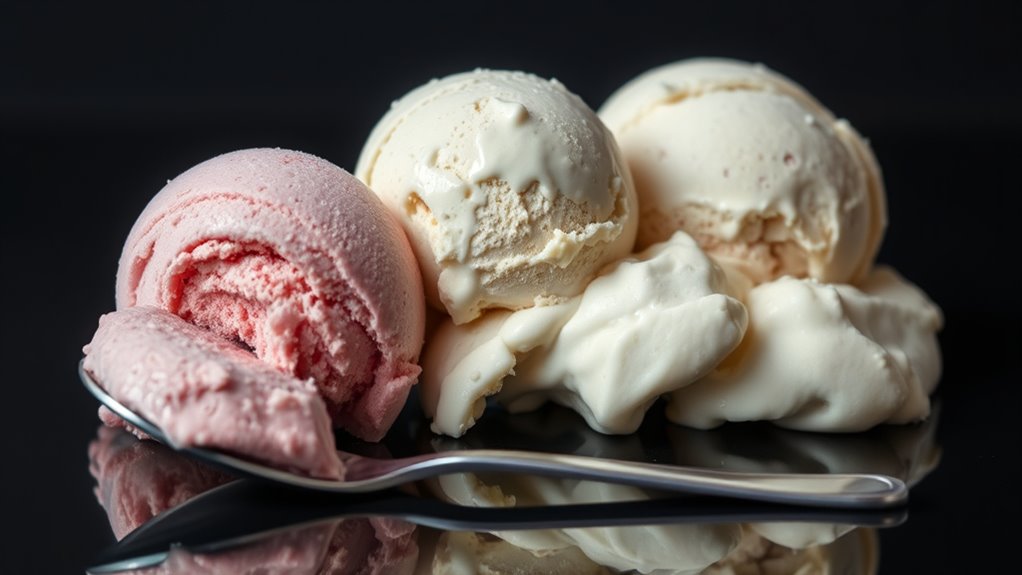When comparing ice cream brands, focus on milk fat content, aiming for at least 10% for creaminess. Pay attention to texture; high-fat ice creams offer a richer experience. Balance sweetness carefully, as too much can overwhelm flavors. For cookie-based flavors, consider the cookie-to-ice cream ratio—more cookies typically enhance enjoyment. Finally, try conducting a blind taste test to really see which brand appeals to your palate. There’s so much more to explore about perfecting your ice cream choices!
Key Takeaways
- Check milk fat content; aim for 10% or higher for a creamy, rich flavor experience.
- Prioritize real ingredients over artificial flavorings for authentic taste and quality.
- Assess the cookie-to-ice cream ratio in flavors like cookies n cream for optimal enjoyment.
- Look for premium brands that offer a velvety mouthfeel and satisfying texture.
- Conduct blind taste tests to fairly evaluate brands based on flavor, texture, and overall satisfaction.
Factors to Consider When Choosing Ice Cream

When you’re choosing ice cream, there are several key factors to keep in mind to guarantee you pick a delicious option.
First, look for a milk fat content of around 10% or higher; this often indicates a creamy texture and rich flavor. Check the ingredient list for high-quality options that feature real vanilla or cream instead of artificial flavorings.
Look for ice cream with at least 10% milk fat for a creamy texture and rich flavor, prioritizing real ingredients over artificial ones.
When selecting flavors like cookies n cream, evaluate the cookie-to-ice cream ratio for better enjoyment. Premium options, like Häagen-Dazs and Tillamook, provide a velvety mouthfeel that elevates your experience.
Finally, don’t forget to browse customer reviews; they can reveal insights into which ice cream brands consistently deliver satisfaction, like Ben & Jerry’s with its creamy texture and rich flavor.
The Importance of Texture and Creaminess

Choosing the right ice cream goes beyond just flavor; texture and creaminess play an essential role in your overall enjoyment. High-fat ice creams, typically with around 10% milk fat, deliver a smooth, rich texture that enhances your flavor experience.
When you opt for denser varieties, you’ll find a creaminess that provides a velvety mouthfeel, making each bite indulgent. Pay attention to the integration of ingredients, like real vanilla beans, which can elevate the ice cream’s texture and authenticity.
Additionally, consider scooping ease; ice creams that scoop effortlessly without excessive thawing often indicate higher quality and creaminess.
Ultimately, a satisfying texture will make your ice cream experience even more enjoyable and rewarding.
Evaluating Flavor Balance and Sweetness

Evaluating flavor balance and sweetness is essential for a satisfying ice cream experience. You’ll want to find an ice cream brand that achieves the right balance, as overwhelming sweetness can mask other flavors.
For instance, brands like Edy’s struggle with this, earning low scores for excessive sweetness. Look for a creamy texture that enhances the flavor profile, like Tillamook Ice Cream, which excels in both richness and texture.
The intensity of the vanilla flavor matters too; ice creams with real vanilla flecks and quality ingredients, such as Ben & Jerry’s, often yield a superior experience.
Finally, consider the melt rate—if it melts too quickly, you might lose that delightful texture and flavor integrity you crave.
The Role of Cookie-to-Ice Cream Ratio

Flavor balance and sweetness set the stage for a great ice cream experience, but the cookie-to-ice cream ratio plays a significant role in elevating that enjoyment, especially in cookies n cream varieties.
A higher cookie-to-ice cream ratio enhances overall enjoyment by providing an ideal mix of cookie crunch and creamy texture. Brands like Breyers excel in delivering substantial cookie chunks, creating a satisfying experience that amplifies the ice cream’s richness and flavor contrast.
In contrast, Häagen-Dazs has faced criticism for a poor cookie-to-ice cream ratio, resulting in a lack of flavor and enjoyment.
Ultimately, finding that perfect balance between creaminess and crunch can make all the difference in your ice cream adventure.
Conducting a Blind Taste Test for Unbiased Results

How can you truly determine which ice cream brand reigns supreme without bias? Conducting a blind taste test is your best bet. Have a partner serve various ice creams without revealing their identities. This way, you can focus solely on flavor and texture. Let the ice creams thaw for about 10 minutes for ideal creaminess. Use a blindfold to block your sight completely. While tasting, pay attention to the cookies-to-ice cream ratio, texture, and overall enjoyment. Record your thoughts for structured feedback and rank the brands from worst to best.
| Ice Cream Brand | Ranking |
|---|---|
| Brand A | 2 |
| Brand B | 1 |
| Brand C | 3 |
| Brand D | 4 |
Frequently Asked Questions
How to Tell if Ice Cream Is High Quality?
To tell if ice cream’s high quality, check the milk fat content; aim for around 10% or more for creaminess.
Look at the ingredient list—fewer additives usually mean better quality.
Feel the texture; it should be dense and creamy, not airy.
Taste matters too; you want a bold, authentic flavor without artificial aftertastes.
Don’t just rely on price; sometimes, budget-friendly options can surprise you with great taste and texture.
What Is the Difference Between Cheap and Expensive Ice Cream?
Did you know that premium ice creams can contain up to 10% milk fat, compared to cheaper ones that often have less?
When you taste the difference, you’ll notice the creaminess and rich flavor that higher-quality ingredients bring.
Cheaper brands might rely on artificial flavors, leading to a less satisfying experience.
What Are the Indicators of Quality Ice Cream?
When you’re searching for quality ice cream, look for at least 10% milk fat, which gives it that creamy texture you love.
Fewer ingredients usually mean better quality, so check for real vanilla or natural flavorings. Visible vanilla flecks can indicate the use of real beans.
Finally, a smooth, velvety texture that melts easily in your mouth, along with a balanced sweetness, signals a well-crafted ice cream.
Enjoy your treat!
What Is the Best Ice Cream From a Supermarket?
When you step into the supermarket, you might wonder: which ice cream is truly the best?
You’ve got options like Tillamook, with its rich creaminess earning top marks, or Great Value, which delivers a fantastic texture at a steal.
Breyers offers delightful cookie chunks, while Ben & Jerry’s impresses with non-dairy flavors.
But don’t forget Häagen-Dazs; its premium quality can surprise you.
Ultimately, the best choice depends on what satisfies your taste buds!
Conclusion
When choosing the perfect ice cream, remember to prioritize texture and creaminess, savor flavor balance and sweetness, and assess the cookie-to-ice cream ratio. By conducting a blind taste test, you can guarantee your choices are based on pure enjoyment rather than brand reputation. So, indulge your taste buds, trust your instincts, and enjoy the delightful journey of discovering your favorite ice cream. After all, the best scoop is the one that brings you joy!










